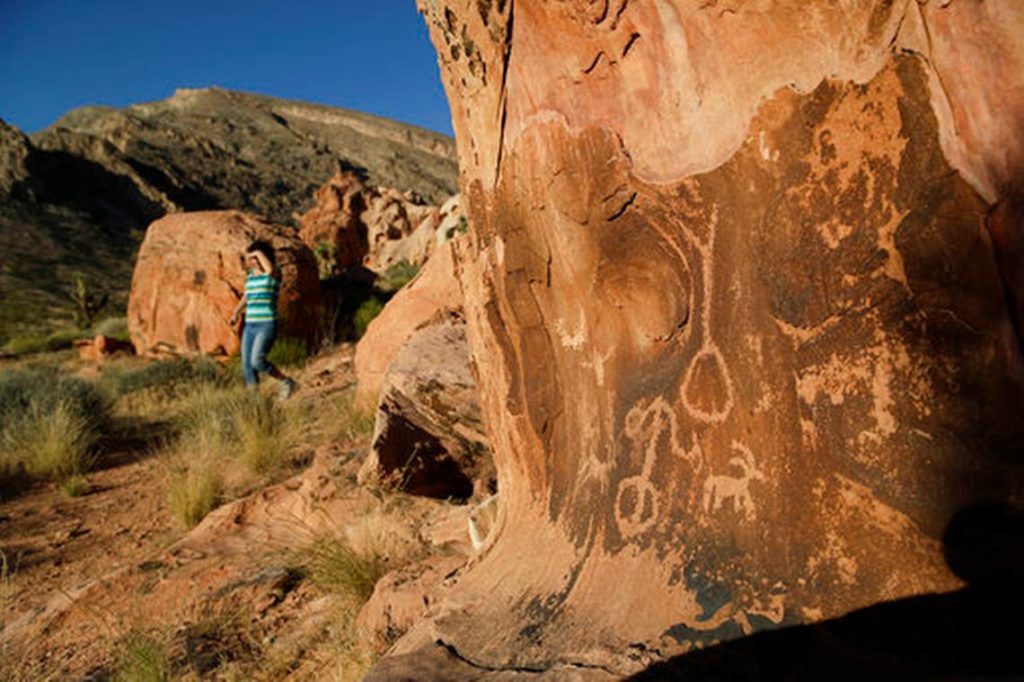Interior chief Ryan Zinke urges shrinking 4 national monuments in West

Interior Secretary Ryan Zinke is recommending that four large national monuments in the West be reduced in size, potentially opening up hundreds of thousands of acres of land revered for natural beauty and historical significance to mining, logging and other development. Zinke’s recommendation, revealed in a leaked memo submitted to the White House, prompted an outcry from environmental groups who promised to take the Trump administration to court to block the moves. The Interior secretary’s plan would scale back two huge Utah monuments – Bears Ears and Grand Staircase-Escalante – along with Nevada’s Gold Butte and Oregon’s Cascade-Siskiyou. The monuments encompass more than 3.6 million acres – an area larger than Connecticut – and were created by Democratic administrations under a century-old law that allows presidents to protect sites considered historic, geographically or culturally important. Zinke’s plan also would allow logging at a newly designated monument in Maine and urges more grazing, hunting and fishing at two sites in New Mexico. It also calls for a new assessment of border-safety risks at a monument in southern New Mexico. Bears Ears, designated for federal protection by former President Barack Obama, totals 1.3 million acres in southeastern Utah on land that is sacred to Native Americans and home to tens of thousands of archaeological sites, including ancient cliff dwellings. Grand Staircase-Escalante, in southern Utah, includes nearly 1.9 million acres in a sweeping vista larger than the state of Delaware. Republicans have howled over the monument since its creation in 1996 by former President Bill Clinton. Cascade-Siskiyou, which juts into Northern California, protects about 113,000 acres in an area where three mountain ranges converge, while Gold Butte protects nearly 300,000 acres of desert landscapes that feature rock art, sandstone towers and wildlife habitat for bighorn sheep and the threatened Mojave Desert tortoise. The Associated Press obtained a copy of the 19-page memo, which was submitted to the White House last month and has not been officially released. Two marine monuments in the Pacific Ocean also would be reduced under Zinke’s memo, and a third monument off the Massachusetts coast would be modified to allow commercial fishing. Commercial fishing also would be allowed at two Pacific sites, west of Hawaii and near American Samoa. President Donald Trump ordered a review of 27 sites earlier this year after complaining about a “massive land grab” by Obama and other former presidents. “It’s gotten worse and worse and worse, and now we’re going to free it up, which is what should have happened in the first place. This should never have happened,” Trump said in ordering the review in April. National monument designations add protections for lands known for their natural beauty with the goal of preserving them for future generations. The restrictions aren’t as stringent as for national parks, but include limits on mining, timber cutting and recreational activities such as riding off-road vehicles. No president has tried to eliminate a monument, but boundaries have been trimmed or redrawn 18 times, according to the National Park Service. Zinke’s recommendations to pare down the four Western monuments – and allow more economic activity at three other sites – “represent an unprecedented assault on our parks and public lands” by the Trump administration, said Jamie Williams, president of the Wilderness Society. “This callous proposal will needlessly punish local, predominantly rural communities that depend on parks and public lands for outdoor recreation, sustainable jobs and economic growth,” Williams said, vowing to challenge in court any actions by the Trump administration to reduce the size of national monuments. It was not clear from the memo how much energy development would be allowed on the sites recommended for changes, but Zinke said in the report that “traditional uses of the land such as grazing, timber production, mining, fishing, hunting, recreation and other cultural uses are unnecessarily restricted.” Those restrictions especially harm rural communities in western states that have traditionally benefited from grazing, mining and logging, said Zinke, a former Montana congressman. “Zinke claims to follow Teddy Roosevelt, but he’s engineering the largest rollback of public land protection in American history,” said Kieran Suckling, executive director of the Center for Biological Diversity, another environmental group. A spokeswoman for Zinke referred questions to the White House, which said in a statement that it does not comment on leaked documents. If Trump adopts the recommendations, it would quiet some of the worst fears of his opponents, who warned that vast public lands and marine areas could be lost to states or private interests. But significant reductions in the size of the monuments, especially those created by Obama, would mark the latest in a string of actions where Trump has sought to erode his Democratic predecessor’s legacy. The recommendations cap an unprecedented four-month review based on Trump’s claim that 1906 Antiquities Act has been misused by recent presidents to create oversized monuments that hinder energy development, grazing and other uses. By sealing off more than 3 million acres in solidly Republican Utah, Obama and Clinton hurt local economies in rural areas that depend on logging and ranching, said Matt Anderson of the conservative Sutherland Institute. “It begs the question: Are these expansions more about ulterior motives like climate change, presidential legacies, corporate interests like outdoor recreation companies, or are they about antiquities?” Anderson asked. Republished with permission from the Associated Press.
Democrats pressure Donald Trump to keep national monuments

Western Democrats are pressuring President Donald Trump not to rescind land protections put in place by President Barack Obama, including Utah’s Bears Ears National Monument. Obama infuriated Utah Republicans when he created the monument in late December on 1.3 million acres of land that is sacred to Native Americans and home to tens of thousands of archaeological sites, including ancient cliff dwellings. Republicans have asked Trump to take the unusual step of reversing the designation, saying it will add another layer of unnecessary federal control and close the area to new energy development. In a letter this week, nine Western Democratic senators wrote Trump to say that weakening protections for Bears Ears or any other national monument would be a direct affront to local communities and stakeholders. “This is especially true in the case of Bears Ears National Monument, for the Native American tribes who call this living cultural landscape their ancestral home,” the senators wrote. The White House has said it is reviewing the decisions by the Obama administration to determine economic impacts, whether the law was followed and whether there was appropriate consultation with local officials. In an ongoing back-and-forth with Republicans over the monument, Democrats on the House Natural Resources Committee released documents Thursday to try to bolster their argument that there was adequate consultation. The documents from Arizona Rep. Raul Grijalva, the senior Democrat on the panel, detail repeated phone calls and visits between the Obama administration and Utah’s congressional delegation and governor. The emails show that Utah officials hoped to work with the federal government on the issue before Obama designated the monument in the final days of his administration on Dec. 28. In an email on Dec. 21, as state officials grew increasingly concerned that the designation was coming, a member of Utah Gov. Gary Herbert‘s staff wrote an Interior Department official and thanked her for her time. “I’m not kidding when I say you’re an amazing example of a public servant,” wrote Herbert’s director of federal affairs, whose name was blacked out in the emails. Democrats said the back-and-forth showed collaboration. “If anyone wants to paint Bears Ears National Monument as a surprise or the product of rushed or incomplete planning, they’ll have to explain hundreds of emails and dozens of pages of shared work product,” Grijalva said. A spokeswoman for House Natural Resources Committee Chairman Rob Bishop, R-Utah, fired back. The spokeswoman, Molly Block, said that releasing the documents was a “desperate attempt to create a façade of local support.” When the designation was announced, Republicans in the state said it was an egregious abuse of executive power. It was opposed by the governor and the entire congressional delegation, in addition to many local residents. Herbert said then that the designation “violated assurances made by (Obama’s) interior secretary to take into account local concerns before making a monument designation.” In his January confirmation hearing, incoming Interior Secretary Ryan Zinke told senators that the president would probably be challenged in court if he tried to nullify a monument, and he would prefer to work with the state. Republished with permission of The Associated Press.


